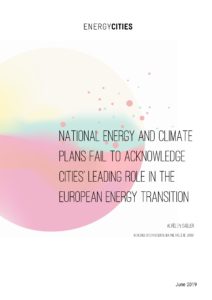Our analysis of EU Member States’ National Energy and Climate Plans reveals lack of recognition towards local action
The draft versions of EU Member States’ National Energy and Climate Plans (NECPs) were to be submitted by the end of 2018. Yesterday, 18 June, the European Commission submitted a review of the plans. EU officials expressed their concern about the plans failing to reach their targets and provided advice on how to fill in the gap to ensure meeting the objectives of the Paris Agreement.
In particular, Member States’ effort in the sector of energy efficiency is highly criticized, as plans in their current states would fail to reach their target by more than 6%. Member States now have until the end of 2019 to take the Commission’s recommendations into account in the final versions of their plans.
Commission’s recommendations to Member States: Where are the local governments?
It appears from an early analysis of the Commission’s recommendations that there is very low local-targeted advice to Member States.
Despite being raised in several “factsheets” (documents that intend to summarise the specificities of each Member States and prepare recommendations), the absence of involvement is not translated into any official – nor binding – recommendations to Member States. It appears that the European Commission, albeit having identified the issue, did not make multi-level cooperation a priority for the amendment of the draft NECPs.
Member States fail to acknowledge city action and multi-level cooperation in their NECPs
We know that cities’ actions are essential to achieve the Paris Agreement’s targets by 2050. Responsible for 80% of energy use and CO2-emissions, local governments are taking action to reduce their energy use and impact on the environment. In 2018, the signatory cities of the European Covenant of Mayors had reached 23% CO2-emission reduction.
Our analysis shows that there is a clear lack of recognition towards cities’ actions from
Our recommendations on how to better integrate local authorities
Notably drawing inspiration from other Member States’ good practices, we recommend Member States to:
- Create specific consultations processes for local authorities.
- Integrate local authorities’ climate and energy good practices in the National Strategy by referencing outstanding actions in the
NECPs and planning on replicating them. - Get inspired
from Member States that are already promoting the scaling-up of their cities’ actions. - Focus on involving cities in “low-emission mobility”, “energy efficiency” and “local energy communities” promotion strategies.
Background information – National Energy and Climate Plans
Under the Energy Union and climate governance rules, entered into force end of 2018, all Member States of the European Union are required to develop integrated National Energy and Climate Plans (NECPs) that cover the five dimensions of the Energy Union. These plans are meant to cover the period between 2021 and 2030, and are to be renewed for every subsequent ten-year period.
These are key instruments that will be used, not only as a means of communication with the European Institutions, but also as an integrated instrument meant to promote multiple dimensions of the climate transition in all EU Member-States, including local and regional level action.
Using the format of multilevel dialogues, the Members States were required to establish consultations with the general public, but also advised to directly consult representatives of local authorities prior to the drafting of their NECPs. Such consultations were not only meant to enable local authorities to express themselves on national measures, but also to support Member States in integrating actions and strategies undertaken by local authorities, such as in the Covenant of Mayors, into the NECPs.

